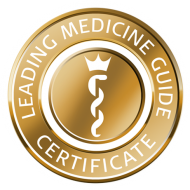Perianal hematomas are also known as anal thrombosis or perianal thrombosis.
At the anus (medically the anal canal), there are blood vessels through which the used blood returns to the heart.
Just like veins in the legs, they are often dilated and form varicose veins. If blood congestion occurs in these vascular bulges, a blood clot (thrombus) can form and block the vein. The accumulated blood causes swelling within minutes to a few hours. The lump-like swelling can grow in size to be as big as a pea or a plum and be very painful.
In this case, physicians speak of a perianal hematoma (also anal thrombosis or perianal thrombosis).
What both perianal hematomas and hemorrhoids have in common is that they are both diseases of the anal canal. Perianal hematomas are often confused with hemorrhoids but have nothing to do with them.
Hemorrhoids are mucosal protrusions of the anal canal, and perianal hematomas are the formation of clots in anal canal veins. If hemorrhoids cause an obstruction in the anal canal veins, the risk of developing a perianal hematoma increases. And conversely, if a perianal hematoma causes the mucosa to bulge and protrude, this can develop into hemorrhoids.
The following factors also increase the likelihood of developing a perianal hematoma:
- Build-up of significant pressure in the lower abdomen:
- This is the case during coughing, e.g., in patients with chronic asthma and coughing fits. But smokers are also more frequently affected.
- Increased pushing during bowel movements can also cause a perianal hematoma, consequently, patients with chronic constipation are particularly at risk.
- Finally, labor and delivery also pose a risk, as heavy pushing can typically cause perianal hematomas. This is a frequently observed complication during childbirth.
- Strained sitting on a cold surface for a long time,
- Warm and humid climate,
- High consumption of alcohol and coffee,
- Frequent consumption of hot spices,
- Diarrhea and constipation,
- Anal sex, and
- Stress.
Compared to deep vein thrombosis (DVT), perianal hematomas originate from superficial veins and are therefore harmless. The most dangerous thing about DVT is developing a pulmonary embolism, which can be fatal. Pulmonary embolisms are generally not observed in thromboses of superficial veins, e.g., in varicose veins in the legs, but also in perianal hematomas. Even though they can sometimes be extremely painful, perianal hematomas are therefore considered a harmless condition.
Perianal hematoma (dotted blue) © Armin Kübelbeck, CC-BY-SA, Wikimedia Commons
A perianal hematoma is indicated mainly by
- The sudden onset of pain at the anus, which makes sitting impossible,
- A massive feeling of pressure or a foreign body in the area of the rectal opening,
- A bluish lump on the anus,
- Swelling, and
- Blood leakage (especially when the perianal hematoma bursts).
In addition, those affected often suffer from
- Itching,
- Stinging, or
- Burning
at the anus.
Perianal hematomas can usually be diagnosed by conducting a physical exam. The taut-elastic, bluish-discolored lump(s) are easily visible externally and painful to the touch. Perianal hematomas are diagnosed visually, as with most other anal conditions. However, the recommendation to exclude additional diseases also applies here.
If the pain is tolerable, a palpation examination of the anus can also be performed to detect or rule out internal hemorrhoids.
Since blood discharge from the intestine can be an indication of a malignant tumor, an additional colonoscopy should be performed after the pain has subsided and the swelling has decreased.
Although perianal hematomas are harmless, they are usually extremely painful. You can use a cold pack to relieve pain and reduce swelling.
To give the skin elasticity, grease ointments such as milking grease or petroleum jelly are also suitable.
In most cases, harmless thromboses heal on their own after two to three weeks. You can promote the healing process:
Ensure soft (not liquid) bowel movements by consuming, for example,
- Wheat bran,
- Psyllium, or
- Flaxseed.
Ingest one to two tablespoons with enough water. Laxatives, on the other hand, impair intestinal activity and therefore do more harm than good!
Clean the anus with water after defecation. To do this, you can wash the anus and then pat it dry with a soft towel. Rubbing the affected area may further irritate the swelling.
Avoid strain that causes pressure to build up in the lower abdomen. This includes, in particular, heavy lifting and excessive pushing while going to the toilet.
Conservative (without surgery) and surgical measures are available for treating perianal hematomas. The goals of conservative methods are:
- Reducing pain,
- Reducing swelling,
- Opening and removing the clot,
- Dissolving the clot, and
- Preventing a recurrence.
Conservative procedures can serve as the sole therapeutic measure, but can also be used in addition to surgery. In particular, a medicine-based pain management as well as the application of ointments are part of postoperative follow-up treatment.
Applying ointment is the main component of conservative therapy. This is also a so-called "local" therapy, which means "affecting a small area". Ointments with a local anesthetic such as lidocaine help treat perianal hematomas. They relieve the pain and thus accelerate the breakdown of the clot.
In addition, pain-relieving and anti-inflammatory ointments can be used. In particular, these include ointments containing diclofenac (a nonsteroidal anti-inflammatory drug). Ointments containing heparin are also often prescribed to speed up the breakdown of the clot.
Ointments with a corticosteroid (cortisone) also relieve the pain. In addition, this reduces swelling. However, their long-term use can damage the sensitive skin of the anal canal. Therefore, they should only be used for a short period of time.
In cases of extremely painful perianal hematomas, "systemic" therapy is recommended and often necessary in addition to ointment application. Systemic, compared to local, means that the therapy acts throughout the body and is delivered in the form of a tablet or infusion. Pain-relieving, anti-inflammatory, and clot-dissolving drugs are the preferred treatment. The ingredients are similar to locally applied ointments; they are nonsteroidal anti-inflammatory drugs such as ibuprofen, cortisone, and heparin.
In exceptional cases, removal of the perianal hematoma under local anesthesia may be considered. Surgery may even be necessary for very large, extremely painful perianal hematomas.
The procedure is performed on an outpatient basis by a proctologist or surgeon. There are two possible options:
- First, a scalpel can be used to open the blood clot (stab incision). It empties the clot by exerting pressure (expression). However, the blood clot is surrounded by the dilated vessel wall of the vein and forms a capsule with it. Therefore, the vascular bulge often fills with blood again.
- As a result, it is not uncommon to use a second method to avoid a recurrence of thrombosis. In this procedure, the entire thrombotic area including the affected vessel segment is removed (excision of the blood clot). To do this, a small incision is first made, then surgical scissors are used to remove the blood clot, including the capsule. Careful hemostasis is then performed and the wound is closed. Finally, a moist dressing with analgesic ointment that reduces swelling is applied.
What is the aftercare?
Many find the pain from the wound-healing process to be much more tolerable than the hematoma-related pain. The mostly mild pain can be easily alleviated with painkillers.
For about a week after surgery, the wound requires special care. It must be thoroughly washed with water after each bowel movement and before going to bed. If this is not possible, a moist dressing should be applied containing a disinfectant and ointment.
Many patients can return to work just one day after the procedure. After two to three weeks, the wound should be completely closed and healed.
What are typical postoperative complications for perianal hematomas?
Generally, no major complications are expected after surgically removing perianal hematoma.
In some cases, the wounds continue to bleed. Slight secondary bleeding usually stops on its own. If this is not the case, another surgery may be necessary. This entails re-closing the bleeding blood vessel with electricity or, where appropriate, suturing. If the wound becomes infected and an abscess containing pus develops, it may be necessary to surgically expose the abscess. Additionally, antibiotic therapy is often required in such cases.
In extremely rare cases, the wound heals poorly, resulting in the development of a chronic tear of the mucosa of the anus (a so-called anal fissure). This can be very painful and must be treated accordingly.




















